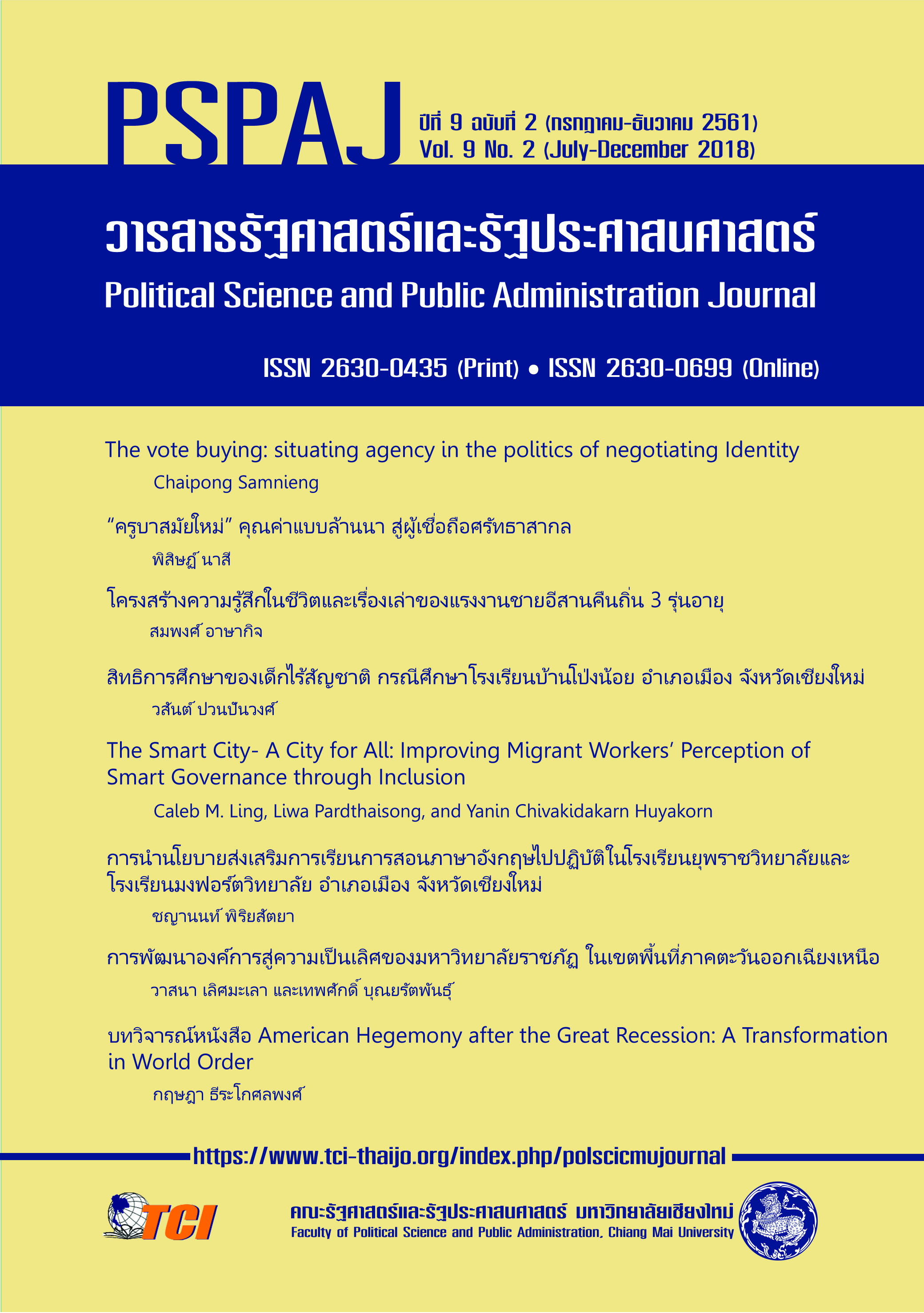Structure of Feeling in Live Experiences and Narratives of Isan Male Migrant Return 3 Generations
Main Article Content
Abstract
In this article I attend to understand about narratives and live experiences of “Isan Male Migrant Return” three generations; composed of generations who have been migrated labor in specific times and spaces. The generations are as follows: (1) over 65 years old, (2) between 45-55 years old and (3) under 35 years old. The article argues that the structure of feeling were expressed in their attitudes, views, thoughts and feelings base on migrating experiences. However, in each generations had structure of feeling that consistent and contradict. The Urban and urban area was senses of bitter, hopeless, insecure and pride by their views of rural people. On the other hand, rurality and rural area was given meaning and values about works and lives in rural area that settled by rural people were 65 years old and between 45-55 years old and unsettled by the rural people were under 35 years old. By the way, all generations have a common feelings: when they reflexive their migrated experiences, they had sense of attachments with rurality. For their migrated experienced in abroad each periods are expressed the structure of feeling of rural people are intersected. The rural people were over 65 years old was inferiority, disappointed, shame and loss and the rural people were between 45-55 years old were aware that labored, hard work. Moreover, they were insulted, exploited, and feel risk in their works. However, the rural people were under 35 years old they were felt pride and unaware that labored and hard work in their job.
Article Details
- เนื้อหาและข้อมูลที่ลงตีพิมพ์ในวารสารรัฐศาสตร์และรัฐประศาสนศาสตร์ถือเป็นข้อคิดเห็นและความรับผิดชอบของผู้เขียนบทความโดยตรง ซึ่งกองบรรณาธิการวารสารรัฐศาสตร์และรัฐประศาสนศาสตร์ ไม่จำเป็นต้องเห็นด้วย หรือร่วมรับผิดชอบใดๆ
- บทความและข้อมูล ที่ได้รับการตีพิมพ์ในวารสารรัฐศาสตร์และรัฐประศาสนศาสตร์ ถือเป็นลิขสิทธิ์ของวารสาร หากบุคคลหรือหน่วยงานใดต้องการนำข้อมูลไปใช้ประโยชน์ในทางวิชาการ ขอให้อ้างอิงแหล่งที่มาด้วย
References
คู, ฮาเก็น. (2552). แรงงานเกาหลี: วัฒนธรรมและการเมืองว่าด้วยการก่อตัวทางชนชั้น [Korean Workers: The Culture and Politics of Class Formation] (ธัญลักษณ์ เหลืองวิสุทธิ์, ผู้แปล). กรุงเทพฯ: วิภาษา. (ต้นฉบับพิมพ์ 2001)
เดอะ อีสานเรคคอร์ด. (2559). อีสานโพ้นทะเล: จำนวนผู้ใช้แรงงานอีสานเดินทางไปต่างแดนมีอยู่เท่าไหร่และเดินทางไปที่ไหนบ้าง. สืบค้นเมื่อ 1 มิถุนายน 2560, จาก https://isaanrecord.com/2016/09/15/อีสานโพ้นทะเล
ไทยพีบีเอส. (2559). ชีวิตแรงงานไทยในเกาหลีใต้. สืบค้นเมื่อ 1 มิถุนายน 2560, จาก https://program.thaipbs.or.th/Tunlok/episodes/39392
ธนพฤกษ์ ชามะรัตน์. (2554). การสร้างเครือข่ายทางสังคมของนายหน้าแรงงานอีสาน. (ปริญญาปรัชญาดุษฎีบัณฑิต), มหาวิทยาลัยขอนแก่น.
ผาสุก พงษ์ไพจิตร, และคริส เบเคอร์. (2546). เศรษฐกิจการเมืองไทยสมัยกรุงเทพฯ. เชียงใหม่: ซิลค์เวอร์ม บุคส์.
พงษ์พันธุ์ ชุ่มใจ. (2561). สาระ+ภาพ: วันเด็ก 2561 ในวันที่เด็กไทยน้อยลงแต่มีความท้าทายอยู่ข้างหน้า. สืบค้นเมื่อ 14 มกราคม 2561, จาก https://prachatai.com/journal/2018/01/74918
พรรณภัทร ปลั่งศรีเจริญสุข. (2551). อัตลักษณ์ของแรงงานข้ามชาติคืนถิ่นกับการต่อรองการพัฒนาของชาวบ้านในจังหวัดลำปาง. (วิทยานิพนธ์ศิลปศาสตรมหาบัณฑิต สาขาวิชาการพัฒนาสังคม), มหาวิทยาลัยเชียงใหม่.
พัฒนา กิติอาษา. (2557). สู่วิถีอีสานใหม่. กรุงเทพฯ: สำนักพิมพ์วิภาษา.
สมพงศ์ อาษากิจ. (2560, กันยายน). การเคลื่อนที่แรงงานของคนชนบทอีสานในรอบ 6 ทศวรรษ: จากชาวนาสู่ ‘กึ่งชาวนา–กึ่งกรรมกร’. การนำเสนอในเวทีรายงานความก้าวหน้า ครั้งที่ 1 โครงการทุนวิจัยบัณฑิต ด้านมนุษยศาสตร์และสังคมศาสตร์ รุ่นที่ 13 ประจำปีงบประมาณ 2560 ของ สำนักงานสนับสนุนการทำวิจัย (สกว.), โรงแรมเดอะทวิน ทาวน์เวอร์ กรุงเทพฯ.
สำนักข่าวไทย .(2560). ขายแรงงาน สานฝันที่เกาหลี. สืบค้นเมื่อ 1 สิงหาคม 2560, จาก https://www.tnamcot.com
สุเทพ สุนทรเภสัช. (2548). หมู่บ้านอีสานยุคสงครามเย็น: สังคมวิทยาของหมู่บ้านภาคตะวันออกเฉียงเหนือ. กรุงเทพฯ: มติชน.
อรรถจักร์ สัตยานุรักษ์. (2559). ลืมตา อ้าปาก: จาก “ชาวนา” สู่ “ผู้ประกอบการ”. กรุงเทพฯ: มติชน.
ภาษาอังกฤษ
Filmer, P. (2003). Structures of Feeling and socio-cultural formations: the significance of literature and experience to Raymond Williams’s sociology of culture. British Journal of Sociology, 54(2), 199-219.
Gao, M. (2017). Unsettled “structure of feeling” of Chinese migrant worker – cases from the service sector of Shanghai. Inter-Asia Cultural Studies, 18(2), 281-301.
Hewison, K., & Young, K. (2006). Introduction: Globalization and Migrant Workers in Asia. In Hewison, K., & Young, K. (Eds.). Transnational Migration and Work in Asia. (pp. 1-11). London and New York: Routledge.
Highmore, B. (2016). Formations of Feelings, Constellations of Things. Cultural Studies Review, 22(1), 144-167.
Keyes, C. F. (2012) ‘Cosmopolitan’ Villagers and Populist Democracy in Thailand. South East Asia Research, 20(3), 343-360.
______. (2014). Finding Their Voice: Northeastern Villagers and the Thai State. Chiang Mai: Silkworm Books.
Kirk, J. (1999). Class, Community and ‘Structures of Feeling’ in Working-Class Writing from the 1980s. Literature & History, 8(2), 44-63.
Kirsch, T. A. (1966). Development and Mobility among the Phu Thai of Northeast Thailand. Asia Survey, 6(7), 370-378.
Matthews, S. (2001). Change and Theory in Raymond Williams’s Structure of feeling. Pretexts: literary and cultural studies, 10(2), 179-194.
Mills, M. B. (2001). Thai Women in Global Labor Force: Consuming Desires, Contested Selves. New Brunswick: Rutgers University Press.
Rigg, J., & Salamanca, A. (2011). Connecting Lives, Living, and Location: Mobility and Spatial Signatures in Northeast Thailand, 1982-2009. Critical Asian Studies, 43(4), 551-575.
Rigg, J., & Wong T.-C. (2011). Contestation and Exclusion in Asian Urban Spaces Under the Impact of Globalization: an introduction. In Wong, T.-C., & Rigg, J. (Eds.). Asian Cities, Migrant Labour and Contested Spaces. (pp. 3-24). London: Routledge.
Salamon, S. (2006). The Rural Household as a Consumption Site, In Cloke P., Marsden T., & Mooney P. (Eds.). Handbook of Rural Studies. (pp. 330-343). London: Sage Publications.
Thompson, E. C. (2003). Malay male migrants: Negotiating contested identities in Malaysia. American Ethnologist, 30(3), 418-438.
______. (2012). Unsettling Absences: Urbanism in Rural Malaysia. Singapore: NUS Press.
United Nation. (2016). International Migration Report 2015. Retrieved June 1,
2017, from https://www.un.org/africarenewal/documents/international-
migration-report-2015
Williams, R. (1977). Marxism and Literature. London and New York: Oxford University Press.
______. (2006). Border Country. Wales: Dinefwr Press.
______. (2011). The Long Revolution. Cardigan: Parthian Books.

